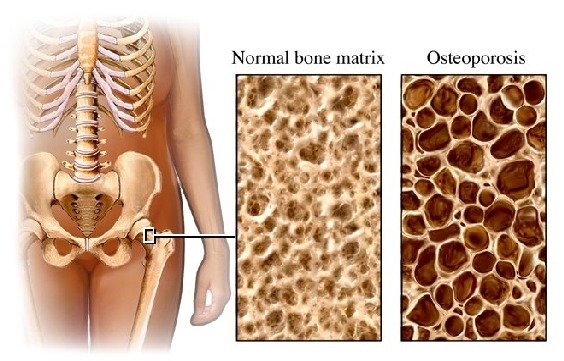
A study published in the American Journal of Clinical Nutrition showed that moderate consumption of wine can increase bone mineral density (BMD) and prevent post-menopausal fractures linked to osteoporosis.
Researchers from the University of East Anglia and Kings College London have studied over 1,000 pairs of female of age about 55. The subjects were questioned about their dietary habits and the scientists have measured the thickness of their bones in the hip joint, the spine and the top of the femur. These are the places in which the bones are broken more often when osteoporosis occurred in post-menopause.
Moderate wine drinkers had higher bone density in the spine and the hip than non-drinkers, or drinkers of other types of alcohol (spirit, beer).

A diet of fish and chips, baked beans, meat pies and cooked meats apparently lowered bone mineral density and a diet high in fruit and vegetables seemed to have no substantial benefits.
“Moderate intakes of alcohol from wine were associated with a higher bone mineral density and the consumption of a traditional 20th-century English diet was linked with a lower bone density,” said scientists.
The findings come before World Osteoporosis Day on October 20, 2011.
Polyphenols, found in the skin of grapes, could help the bones strengthening, not the alcohol, other studies have suggested. Polyphenols are known as antioxidants and they help to prevent heart and brain diseases (stroke, Alzheimer’s), besides osteoporosis.
While a glass a day could prevent osteoporisis, and smaller studies have suggested alcohol might have a protective effect, heavy drinking is known as a major factor that weakens the bones, and leads to osteoporosis.
It is not the first time when researchers focus on the linkage between osteoporosis and wine.
Katherine Tucker, professor of nutrition and epidemiology at the USDA Human Nutrition Research Center at Tufts University in Boston, said in 2004 that beer could prevent osteoporosis in men bones, while wine is good for women bones. Beer contains silicon and wine polyphenols. The study was performed on 2,900 men and women, but there were not enough men who had drunk wine, nor women who had drunk beer, thus, the study only linked men to beer and women to wine. However, Professor Tucker said it is possible that men could benefit from two glasses of wine, while women from two cans of beer.
The study was presented at the American Society for Bone and Mineral Research annual meeting. Men who drank one to two beers a day had around 7% higher hip bone mineral density than nondrinkers. In women, increase was slightly less but was still significantly better than bone mineral density in nondrinkers.
The same message about the importance of moderation was sent at that time too, because “while two cans of beer or two 6 ounce [177,44 ml] glasses of wine are good for bones, drinking more is harmful,” and about distilled beverages (vodka or Scotch) “daily consumption of more than two drinks promotes osteoporosis,” Professor Tucker said.
What is osteoporosis?
In children bones grow and regenerate rapidly, but in adults the process is slower. Over the age of 30 a person starts to lose bone mineral density. Through life old bone is being destroyed by osteoclasts and new bone is formed by osteoblasts. The osteoblasts (cells that produce new bone) became gradually outnumbered by osteoclasts (cells that remove the calcium and phosphorous from an old bone). The balance between these two types of cells is very important for a healthy bone.

Osteoporosis (porous bones, from Greek: ὀστέον/osteon meaning bone and πόρος/poros meaning pore) is a condition that causes bones to become weak and fragile and to break (fracture) easily. It appears frequently in the spine, wrist and hips. Osteoporosis is called a silent disease because lots of people become aware of it only until a fracture occurs.
The gold standard for diagnosis is dual energy X-ray absorptiometry (DXA, formerly DEXA). It measures bone mineral density and expressed it in standard deviations from a young adult reference population (T-score).
* T-score -1.0 or greater is normal
* T-score between -1.0 and -2.5 is low bone mass (osteopenia)
* T-score -2.5 or below is osteoporosis
Osteoporosis affects an estimated 75 million people in Europe, USA and Japan.
Steroid drugs, smoke, heavy drinking and a family history of osteoporosis are important risk factors.
Worldwide, an osteoporotic fracture is estimated to occur every 3 seconds, a vertebral fracture every 22 seconds.
Osteoporosis is estimated to affect 200 million women worldwide – approximately one-tenth of women aged 60, one-fifth of women aged 70, two-fifths of women aged 80 and two-thirds of women aged 90.
About 20-25% of hip fractures occur in men. The overall mortality is about 20% in the first 12 months after hip fracture and is higher in men than women.
It is estimated that the lifetime risk of experiencing an osteoporotic fracture in men over the age of 50 is 30%, similar to the lifetime risk of developing prostate cancer. (Source: International Osteoporosis Foundation).
Can osteoporosis be prevented?
First the risk factors have to be removed. Adequate nutrition (with food rich in proteins, calcium and vitamin D), daily moderate sun exposure (to stimulate vitamin D production) and adequate exercise can slow osteoporosis progression and prevent fractures. An excessive exposure to ultraviolet radiation increases the risk of skin tumors or melanoma. Childhood and adolescence are the perfect times to improve bone mineral density through exercise and to prevent osteoporosis.
2011 World Osteoporosis Day Animation (video)
[youtube 9FTyCo89mCo]
Osteoporosis-3D Medical Animation (video)
[youtube rHyeZhcoZcQ]